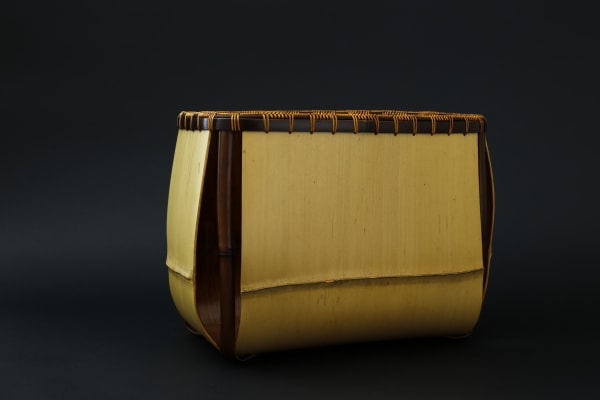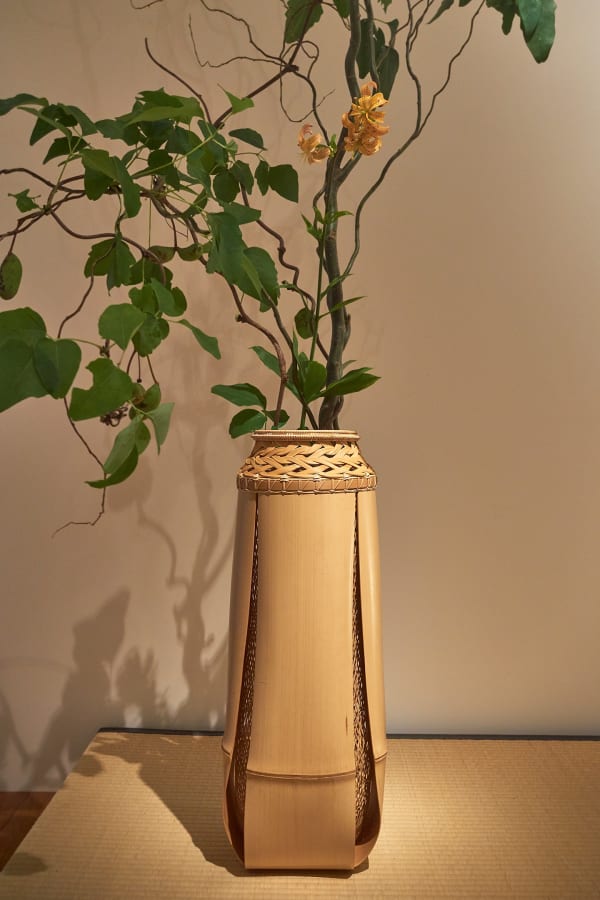Bamboo Exposed: Mastery in Modernity of Hafu Matsumoto
Bamboo Exposed
Shoko Aono
Bamboo has played an important role in Japanese culture since earliest times. Its elegant form, its straight, hollow, green stems reaching up into the skies, symbolize purity and good fortune. In ‘Kaguyahime (The Tale of the Bamboo Cutter)’, which is said to be the world’s oldest science fiction story, a bamboo is cut open to reveal a beautiful princess. The story ends with messengers coming down from the moon to take her back into space with them. Bamboo possesses a strange spiritual and magical power that leads us all towards heaven.
Hafu Matsumoto’s studio is located in the southern part of the Bōsō Peninsular, where the wind blows off the Pacific Ocean, and he listens to the sound of this wind rustling through the bamboo groves as he works. He says of his work, ‘Fresh, green bamboo possesses more than enough beauty on its own. I cut its life short so the least I can do is to preserve its suppleness forever by sealing it within bamboo basketry.’
As the last apprentice of Shokansai Iizuka (1919–2004, designated a living national treasure in 1982) who was himself a second-generation apprentice of the genius, Rokansai Iizuka (1890–1958), Hafu Matsumoto is exceptionally skilled and has mastered the shin, gyō and sō (formal, semi-formal and informal methods) of weaving. One moment his expression resembles that of a samurai, as he struggles with the unforgiving bamboo, then the next he will resemble a peaceful priest as he works with the material’s flexible nature. In his work, Matsumoto conforms to the golden rules that guided Rokansai and Shokansai throughout their lives.
The ‘Noshitake’ series, around which this exhibition structured, utilizes the ‘Sō’ (informal) technique that was developed by Rokansai. Its very simplicity allows the viewer to feel the vigor and refinement possessed by the craftsman. Pieces of bamboo, that have been split open then flattened by soaking them in boiling water, are bent together vigorously to create objects in which the tension resulting from the bamboo’s natural tendency to stand erect, produces graceful forms. Tension and quietude are born from the enthusiastic dialog between Hafu and the bamboo. Hafu Matsumoto’s bamboo baskets present a new form of bamboo craft suited to the twenty-first century that will doubtlessly weave a new future for Japan’s unique traditions.
Ippodo Gallery is pleased to present a solo show of Hafu Matsumoto
(b. 1952), the last disciple of Shokansai Iizuka (1919-2004), dedicated to the tradition and innovation of Japanese craftsmanship. 20 of works will be on view, demonstrating the evolution of bamboo artistry through the solo showcase of Matsumoto’s unique skill. The exhibition coincides with Japanese Bamboo Art: The Abbey Collection, which reunites the works of both his teacher Shokansai and his father, the master Rokansai, at the Metropolitan Museum of Art this June.
The Bamboo Legacy
Although bamboo has been prized for thousands of years as a functional material, the Iizuka family led the life of modern bamboo. The legendary Take (bamboo)-Kôgei (craft) master Rokansai Iizuka’s (1890-1958) life’s ambition was to bring flattened bamboo art to the forefront. He was among the earliest pioneers striving to showcase bamboo as a significant art. His strong will and and extensive artistic training in drawing, painting, calligraphy, and poetry infused his interest in bamboo with a diverse range of knowledge and style.
Because Rokansai studied Sadô (tea ceremony) and Ikebana (flower arrangement), he manifested three styles of tea ceremony and brought them into Take- Kôgei. Iizuka’s bamboo wares are in one of three categories: Shin (真), Gyou (行), and Sou (草). Shin is characterized by elegant attention to detail in technique, while Gyou is a more relaxed. The earthiness and simplicity of the Sou style renders it the most difficult. Sou, known as wabi-sabi, is beautiful in its imperfection. In its reflection of reality, the true challenge is revealed.
Shokansai was Rokonsai’s son. He pursued basketry under the family’s legendary master. He enhanced Rokansai's efforts in bamboo with the prized embroidered plaiting technique, Sashiami, as well as bundled plaiting, Tabaneami, and irregular 'cracked ice' plaiting, Hyoretsuami. As his career progressed, the dedicated Shokansai received the honor of Living National Treasure in 1982.
Hafu Matsumoto Today
Deriving from bamboo’s humble heritage and Rokansai’s groundbreaking technique, Matsumoto was Shokansai’s last apprentice. As such, Matsumoto’s work guards Japanese functional traditions while innovating bamboo as a sculptural form. His methodology at once embraces yet opposes the original traditions, challenging in its bridge between bamboo’s artistic future and its past. That Matsumoto is one of few living artists upholding these three techniques today is rare and significant.
Rokansai developed the Noshitake technique in Sou, but only Hafu Matsumoto has reprised it. The bamboo is carefully boiled, stretched, and ironed flat for its final smooth and malleable texture. It is hard work but the passion for the craft takes precedence, and the desire to present every aspect of the unmarred bamboo at its highest quality. As Matsumoto has said, “I weave bamboo with my pleasure. I weave by my body and mind, not by my hand.”
Hafu Matusmoto’ s current Noshitake took shape by trial and error. He learned the process himself through careful study. There are two general techniques within this bamboo art:Ami (Weaving) or Kumi (Crossing). This new development, Noshitake, does not belong to either one.
He continues to train in the traditional martial art and sword practice of I-ai dô, and studied Kendô, Japanese fencing, in childhood. He applies this discipline to the crafting of bamboo arts, treating it like the dō (way) he still studies today.
Bamboo is the severest material in Japanese Kôgei. Its endurance is reminiscent of a person of principle; its unbending nature esteemed mimic a strong, open mind. Like bamboo, the artist and his work have a straightforward and independent spirit: deceptively simple, yet all-encompassing. Much of the artist’s process is based in the preparation of the bamboo itself. Craftsman face the rawness of nature, held captive by the material’s properties. While these bamboo challenges can break the spirit like a dull blade, the obstacles are what make Take-Kôgei so unique.
Ultimately, Ippodo Gallery’s commitment to harmony in the natural world is consistent in this exhibition. Bamboo’s unyielding nature and the integrity of the form preserve the earth’s untouched beauty.
Artist Bio
Hafu Matsumoto was born in Haneda, Tokyo, in 1952, and began apprenticing for Shokansai Iizuka in 1972. In 1976, he opened his first studio in Kyoto, subsequently moving to his present studio in Tateyama City, Chiba Prefecture. He has held solo shows in Tokyo, and been featured in group shows across Japan, New York, and the Asian Art Museum in San Francisco. He accepted the Chairman’s prize at the 61st Japan Traditional Kogei Exhibition in 2014.















